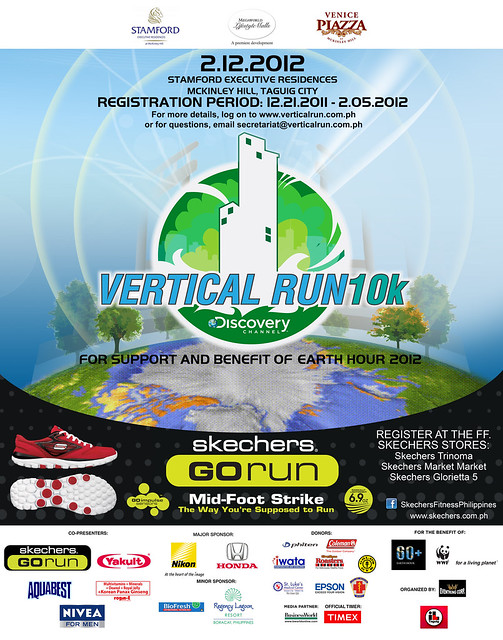
Discovery Channel
presents
Vertical Run 10k
McKinley Hills, Taguig City
February 12, 2012
I’m very excited and looking forward to this vertical run in Stamford Executive Residences on February. This is stairs running!!! Rock on.
For the first timers in vertical running like me, I am sharing to you some stair training I got from Mark Verstegen of http://coreperformance.com
Here it goes:
The Ascent
On the way up the stairs, think “more power.” Climbing every other step is terrific, but focus on actively extending your leg and driving your foot down into the top of the step as if you were taking off for a lay-up or dunk. This produces the greatest force and creates a far superior triple extension of your hips, knees and ankles, meaning you’ll generate more power.
Also, pull your toes up toward your shin on the lead leg. If you’re landing on your toes with your heel way up off the ground, you’ll like suffer shin, knee, hamstring, hip flexor or back problems sooner or later. Keep your toes up with the weight on the ball of your foot and push through your leg.
The Descent
The trip down is where pain most often occurs. Here’s how to avoid it.
Absorb the impact with your butt.
On the way down, there is a tendency to have “knee dominant absorption” instead of “glute dominant force reduction.” This simply means that most people absorb the impact with their knees instead of using their hips. The force that’s created by your body weight dropping the distance of 1-2 steps compounded by gravity and poor biomechanics can cause muscle soreness or exacerbate tight areas, leaving you more prone to injury.
Be aware of the your alignment.
Try to keep your knee in line with the second toe. And don’t forget to use your hips. The tendency is to hike your hip on the opposite side or swing your hip out to the side instead of keeping it behind you. If you’re having a hard time controlling this posture on the way down, use a hand railing if there is one.
Use your recovery strategies.
Reduce aches and pains with self massage using a foam roll, massage stick, or Trigger Point kit. Key areas include a small muscle called the tensor fascia latae, (start at your hip bone and work down the side and front of your thigh), your piriformis (on the back of your hip where your wallet would be) and your lateral quadriceps (down by the outside of your knee).
Stair Workouts
Keep making progress on the stairs with a planned progression. For any readers who have never tried stair training, simply start by walking up and down the stairs. Then use the progression below to slowly increase the intensity and effectiveness of your training:
Jog up and walk down.
If using bleachers, jog up, walk across the top, then walk down.
When you get in better shape, instead of walking across the top of the bleachers, just come down (less rest makes it harder).
Run up, run down, rest, and repeat. Depending on the length of stairs, you can continually challenge yourself by increasing your speed and the number of repetitions you do (going up and down once equals one rep).
If you’ve already been doing stair training, step it up a level:
Level 1: Run up for 6-12 seconds, then slowly walk down. That’s one repetition. Repeat for 6-12 reps.
Level 2: Sprint up for 8-12 seconds, then walk down. That’s one rep. Do one to two sets of 8-12 reps.
Level 3: Run up for 12-20 seconds, then walk down. That’s one rep. Do two to three sets of 8-12 reps.
Leave a Reply